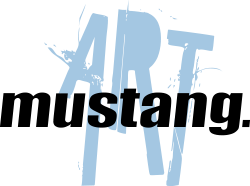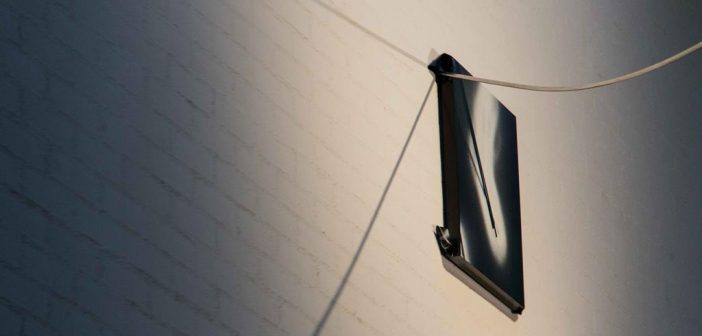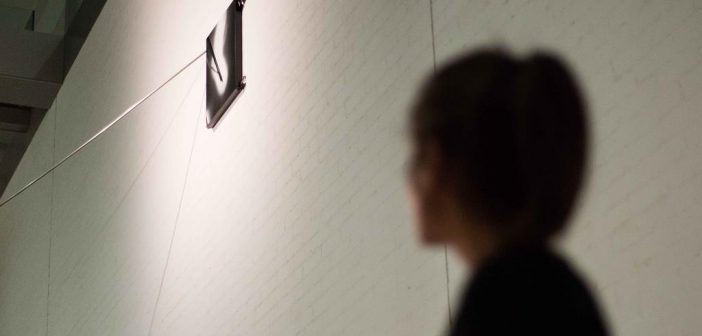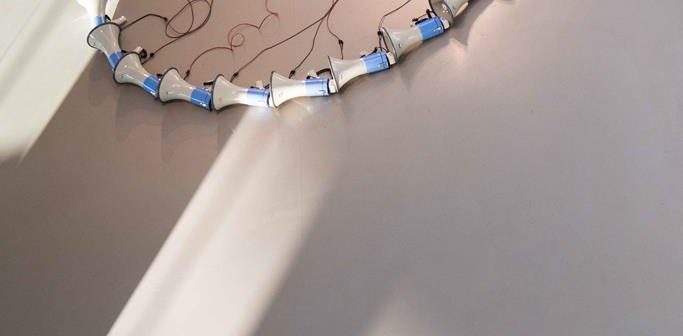EFECTOS SONOROS
Nuria fuster, Pablo Bellot y Rubén M. Riera
8 de Abril al 22 de Junio
When the world is your own echo chamber.
Johanna Caplliure
“Los objetos que rodean mi cuerpo reflejan la acción posible de mi cuerpo sobre ellos”. (Henri Bergson, Materia y memoria)
La posibilidad de un cuerpo se abre en la acción producida por este. Esta acción puede obrarse sobre el propio cuerpo que actúa, sobre los objetos que le rodean o sobre el propio espacio en el que se sitúa. Cuerpos y objetos parecen cobrar la forma de un reflejo, los unos responden en los otros, como un espejo o como un eco.
Efectos sonoros es un dispositivo expositivo experimental de parámetros abiertos. Entre lo sensible y lo inteligible, la acción humana y los procesos de producción de sonido, las frecuencias y las ondas, el silencio y la palabra todo cobra sentido en su trasmisión. En ocasiones la recepción acústica se confunde con la repetición de la acción, como un eco. A cada secuencia de acciones le siguen consecuencias más o menos predecibles o contingentes de un nuevo cuerpo sonoro. Cuando nos aproximamos al sonido desde Efectos sonoros lo hacemos poniendo nuestro cuerpo en el centro de acción. Los tres artistas elegidos para este proyecto, Nuria Fuster, Rubén M. Riera y Pablo Bellot parten de este cometido, la acción del cuerpo, como formulación de efectos sonoros en los que se incluyen el silencio, el ruido, el eco o la reverberación.
Sounding Stone, Nuria Fuster.
Una plataforma de hierro diseñada para que el cuerpo esté abocado a vivir una experiencia que transforme sus sensaciones. La estructura de metal rompe su horizontalidad en una elevación ligera pero precisa para su finalidad. La elevación y su tendencia produce cierta inestabilidad del paso, inclinando el cuerpo que camina sobre la superficie metálica que genera una sensación de vértigo. El vértigo aparece como una sensación de mareo, de movimiento exterior que puede conducir incluso a la caída por la pérdida del equilibrio. Sin embargo, el vértigo es la consecuencia de la descompensación del oído que produce un desequilibrio en la aprehensión del espacio circundante. La inclinación de la plataforma representa la misma tendencia que produce el vértigo: un ligero o grave declive en nuestro contacto con la realidad. El vértigo produce una sensación de movimiento irreal, puesto que se trata de una sensación subjetiva de movimiento. El trastorno del desequilibrio constituye un cuestionamiento importante en cómo se reflejan los cuerpos en el espacio. Puesto que estos no son solo percibidos, sino apercibidos por sentidos como el oído que es capaz de recrear situaciones, espacios y cuerpos mediante las ondas que produce el movimiento de estos. Al igual que la experiencia de vértigo, Sounding Stone de Nuria Fuster reflexiona sobre las relaciones entre nuestra interioridad y exterioridad.

Efectos Sonoros
El silencio de un cuerpo, Rubén M. Riera.
Un vídeo multicanal fragmenta la imagen de un brazo que con la mano abierta y boca abajo se sitúa sobre un fondo negro. La imagen dividida en cuatro pantallas descompone en cierto modo la figuración real. La mano permanece inmóvil hasta que la escala musical entra en escena: un “Do” se extiende a lo largo del plano y cuando cesa, la mano golpea el fondo negro. Repentinamente este aparece como un agua negra, algo imposible en su sustancia natural. Y entonces las ondas producidas por el choque de la mano en el agua provocan un titilante movimiento lumínico. La luz emana del agua en ondas cuando el sonido desaparece. Así la escena se convierte en una doble realidad. Como en el caso de la reverberación, un cuerpo de producción acústica pierde en la repetición su forma transformándose en otra figura.
Lapsus es el nombre del proyecto en el que Rubén M. Riera inserta El silencio de un cuerpo y como tal nos advierte de un tiempo entre dos límites. El lapso de tiempo anuncia ese transcurrir entre los límites del audiovisual. El sonido precede a la imagen que parpadea como un eco transfigurado. Al “Do” le sigue el resto de la escala en este inusual causa-efecto invertido. Este espacio de tiempo es capaz de construir una imagen audiovisual en virtud de una virtualidad del presente en el se entremezclan materialidad e inmaterial en un tiempo de dos.
El grito _ Acto de comunicación nº2, Pablo Bellot.
El cuerpo, de nuevo, se pone en el centro de la acción. Un puñetazo parece ser el acto que Pablo Bellot elige como evocación del primer ejercicio de comunicación. El grito _ Acto de comunicación nº2 toma como inspiración la cita de Paul Virilio: “El puñetazo es el principio de la comunicación: con el puñetazo se gana proximidad cuando ya no se tienen palabras”. Si la palabra parece el acto de comunicación más sofisticado del ser humano en el que sonido, idea y creación van de la mano brindándonos la posibilidad de encuentro, el grito -como un puñetazo- rompe con la reglas de la transmisión del mensaje. Un acto de fuerza que imprime la posibilidad de disenso. Sin embargo, este grito queda enmudecido.
En la instalación observamos como un círculo de veintiocho megáfonos rompen con todo mensaje probable. Si la finalidad del megáfono es ampliar el sonido, en este caso amplificaría el grito, este queda enmudecido por el ruido infinito. Un megáfono conduce el sonido a otro megáfono que a su vez reproduce el sonido en otro dentro de una cadena circular irrompible. Entonces el sonido ampliado permuta en ruido.
Los efectos sonoros implícitos en los tres casos nos hacen experimentar cómo el mundo deviene una caja de resonancia permanente.





























